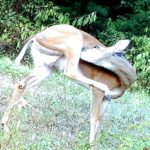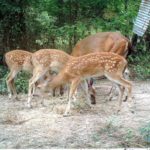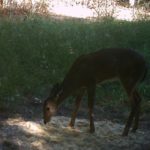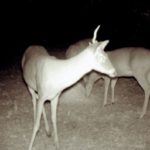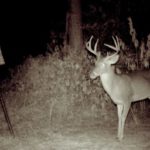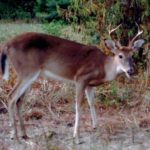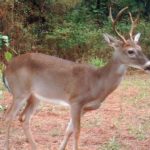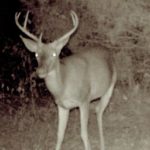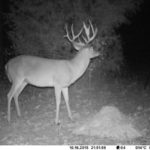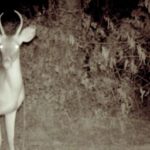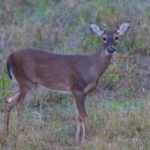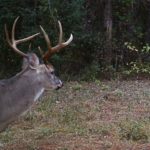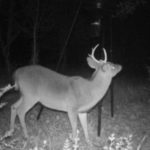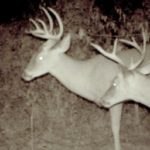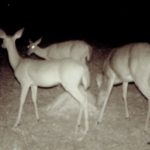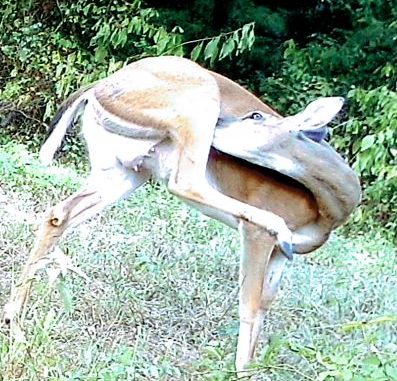
The unseasonably hot weather early in the season put a crimp in your deer hunting. Your trigger finger is twitching as the season reaches its final month, but should you really shoot that deer?
Deer hunting has gone full circle. In the ’60s, bucks-only hunting was the rule and any legal buck was fair game. No one was going to harass you at the game pole about the size of your deer.
In the ’70s, as deer herds began to really expand across the state and deer numbers increased, bucks-only hunting was still the name of the game despite the high numbers of deer.
But racks were getting smaller.
In the ’80s, DMAP came on the scene and hunters began to get interested in deer management — and there was concern about the lack of bucks with big antlers.
Most of the buck kill consisted of 1 ½-year-old bucks, and in some clubs this age class accounted for 70 to 90 percent of the buck kill.
It also became fashionable to shoot does and start managing deer herds.
In the 1990s, the idea of “let them go and let them grow” (aka quality deer management) took hold, and hunters began passing up small bucks.
Today you will either be rung up the flag pole or fined for hanging a young buck in the cleaning shed.
But, alas, it seems the high deer numbers of the ’70s and ’80s have declined to the point that hunters are now crying about not seeing any deer, so hunters have not only stopped shooting bucks but they have also gone back to the days of not shooting does in hopes of increasing deer numbers.
It is hard to have your cake and eat it, too.
So, with today’s mind set, what are you going to shoot when you go out in the woods?
The answer probably depends on the deer habitat you are hunting in, the goals of the club or landowner for the land on which you hunt and what you as a hunter have established as an individual goal for this hunting season.
Some hunters who have killed a few deer might strictly be looking for trophy-class bucks. Hunters who have not killed a deer or have only killed one or two might be looking for anything with antlers.
Hunters on clubs trying to manage their herds for quality bucks will still be targeting does and the older adult bucks.
Those who enjoy eating venison and sausage are probably looking for anything that is brown.
And old hunters like me just hope we can enjoy a day in the field without breaking down — and for some of us old codgers, what we shoot depends on how far we have to drag it to get back to the truck.
By now, you know the rules of the Shoot-Don’t Shoot game: Study the photo and decide if you should pull the trigger or release the arrow.
After the photos you will read my comments. Keep in mind that I am management oriented, but I also still enjoy shooting deer, eating venison, and sharing the game with family and friends.
No. 1
It is opening day of the bow season in the area you hunt. A doe has just walked out and is heading your way.
You draw back and begin to aim. The doe stops and you get your aim.
Suddenly the doe raises its rear leg and begins to lick itself. You now notice her full udder, and it is obvious she is nursing fawns.
What will you do?
No. 2
You are set up over a feeder and rice bran. The weather this season has been the pits with temperatures often rising into the 80s. But today it was a little cooler, so you opt for a late afternoon hunt.
You get in the stand around 3, and within a matter of minutes you detect movement in the woods. Your heart begins pounding and you scan the woods closely, looking for that buck you have been getting lots of photos of.
All of a sudden three fawns come running out and begin feeding. A few minutes later the adult doe comes out and joins the group.
Four deer within easy bow range — more deer than you have seen all season. Obviously, it is illegal to shoot spotted fawns but the doe is fair game.
Or is it?
No. 3
Another evening bow hunt but in a different location. Deer and pigs have been visiting this spot, feasting on the corn and rice bran.
A small deer walks out and begins feeding. A closer look shows you it is a nubby buck, a 6-month-old deer.
You spent a lot of money on this new bow and are eager to try it out. And you are fully aware that your neighbors only hunt with guns.
What are you going to do?
No. 4
Gun season is open around the state, but the winter weather has not made an appearance. Deer movement has been poor, and you haven’t seen nothing at all bow hunting.
But today a crooked-antlered buck with basically one big spike has walked out and is acting a little nervous.
You better decide quickly.
No. 5
The rut is on and bucks are chasing does. You’ve been sitting in your stand all morning, when suddenly a good-looking 8-pointer walks out and searches the area.
You know what he has on his mind, and now is the time to make your decision.
No. 6
The holidays are winding down, and you have seen absolutely nothing all season. Monday morning you will be back at the desk.
But your luck has changed and a 5-point buck steps out to feed. Do you finally get to use one of your buck tags?
No. 7
You have had a good season so far, killing two nice 8=points. And, as you think about the days you have left to hunt, a buck with a tall rack steps out of the woods.
Is this the season you get to fill all three buck tags?
No. 8
There is still a full month of hunting left in the 2015 deer season, and you have buck and doe tags burning a hole in your wallet.
Here comes a buck with a 15-inch inside spread, but it only has one brow tine. Is it time to end buck hunting this year?
No. 9
You’ve seen bucks chasing does all morning, and you’re a nervous wreck. None of the bucks would slow down long enough for a shot.
All of a sudden from out of nowhere this buck comes walking in and goes to a scrape that you had not noticed.
The moment of truth is here, but are you going to shoot this deer?
No. 10
A buck comes strolling over the ridge and heads down to the creek where you are set up. The woods are full of acorns and this buck is taking its time eating them.
Is this a deer for you?
No. 11
You are on a deer hunt with dogs. You haven’t been hunting like this in years, and you are enjoying the sound of the hounds as they chase the deer around.
You have seen a few white tails, but none of the deer have stopped and given you time to look at them.
Then this buck comes running across the right of way and stops. It’s now or never — if you are going to shoot.
No. 12
You have killed two does this season, but buck sightings have been non-existent. Your luck has changed, and a deer with a nice-looking rack has come out into your opening.
Are you going to take advantage of what Lady Luck has just given you?
No. 13
It’s opening day of gun season, and you are in your favorite stand. A buck with a big neck and small rack steps out.
You have to decide quickly because it knows something is not right in deer paradise.
No. 14
The bucks are still together, so you know the rut has not started. These two have come to the feeder to feast on the groceries you have been buying for them.
At first glance both look pretty good, but you know the legal limit is only one buck a day. Will you shoot one of them?
No. 15
It is a legal doe day, and three big ones have just walked out to the feeder. But do you really want one of these slick heads?
The answers
Keep in mind that deer hunting is recreation, and as long as you are following the rules and regulations there is really no right or wrong answer.
Of course, some clubs and landowners have established guidelines for their properties, and as a hunter you should respect their restrictions and follow the management program they have established for the land.
There are no stands with spectators watching you as you hunt and enjoy yourself in the woods. Your decision to shoot or not to shoot a deer is something you have to decide for yourself — and once you have made that decision and the deer hits the ground, you have to live with it.
While hunting is fun, the killing of wildlife is something that should not be done just for the sake of killing it because you can. You should always respect the resource and never waste what God has blessed us with.
With all that said, here are my thoughts on each scenario:
No. 1 — A doe licking its leg
It is obvious that this doe is or has been nursing fawns; it takes a while after a fawn is weaned for the udder to dry up.
In fawns are 4-6 months old and are fully weaned and can survive on their own, but like all animals will nurse as long as mama lets them.
In Areas 1, 4 and 6 (the late-breeding and fawning areas), fawns in October are often less than two months old and are still nursing heavily. This is the reason for the delay in the doe shooting in Area 6.
Most hunters would probably pass on this shot.
No. 2 — A doe with triplets
Adult does on good habitat and where herd numbers are in line with the habitat will produce twins and sometimes triplets.
This obviously is a good productive doe. So it might be wise to pass on this doe and keep her in the herd.
You could perhaps look closely at her and see if there are identifiable characteristics that you could pass along to others so that they too might not shoot her.
No. 3 — A nubby buck
Hunters on most clubs and private lands frown on shooting nubby bucks because they believe these are the bucks of the future — but are they?
If you are managing your habitat and herd they might be, but if not there’s nothing is wrong with sampling a few 6-month-old males and getting data for growth and development trends.
What you do not want to do is shoot high numbers of both the 6-month-old males and the 1 ½-year-old males because this will reduce the number of males in the adult age classes.
No. 4 — The buck with one antler
I am not sure what is going on with this buck, but it is not good. The body size suggests it might be a 2-year-old adult.
Whatever the case, the antler growth is not desirable. Shoot it, tag it and report your tag.
No. 5 — Nice 8-point
Hunters looking for a real trophy might pass on it, but this buck is at least 3 years old, and would make most hunters happy.
This is a good deer, and would be one to harvest.
No. 6 — A little 5-point
This is a 1 ½-year-old buck living in Area 2 and will only get better, but this is one each hunter must decide on.
But, again, sampling a few deer from this age class to help determine growth and development trends is wise management.
Just don’t go overboard.
No. 7 — A tall 5-point
This is another 1 ½-year-old buck from Area 2 that will probably continue the same antler-growth trend as it gets older.
It would be fun to see what it has in two more years, so let it go and let it grow.
No. 8 — The old one brow-tine buck
This is an adult buck showing very mediocre antler growth. Shoot it, tag it and report your kill.
No. 9 — The dream-season buck
Some landowners might want hunters to pass on this buck and see what it does as it gets older. But it is already 4 ½ years old, and is a great deer.
I would not try to carry this buck over to the next year and run the risk of it dying from disease or an accident. Shoot it and bring it to the Sportsman Show.
No. 10 — A nice spike
This is another 1 ½-year-old buck with decent spikes. It is not an old adult cow-horn spike you hear hunters talking about.
Nothing wrong with shooting it, but it is going to get better as it gets older.
No. 11— The spike runt
While most hunters would ask you why should shoot this buck, it is a low-end 1 ½-year-old and will never be the buck that No. 10 would be.
It is behind in body weight and antler growth, and the groceries on the pine habitat where this deer is living will not let it catch up.
This is one that a management program collecting good harvest data would show is below average and probably best to harvest.
In all age classes there are bucks above and below the average: Let the better ones get older, and target those below-par animals.
No. 12 — The big, heavy 8-point
A good target buck for any program. This buck is an adult — 4 years or older — so harvest it, tag it and report the kill.
No. 13 — An adult 5-pointer
Body size tells you this is not a 1 ½-year-old buck. The rack is small, and the growth pattern is not really desirable.
There’s no reason at all not to harvest it.
No. 14 — Two adult bucks
You should have recognized these two bucks (No. 5 and No. 8). These two were feeding together during the preseason in Area 2.
Both are shooters, but since you can only shoot one, I would opt for the buck with the one brow point and remove it from the herd. It is not showing the quality growth of the nice 8-point.
No. 15 — Three does a feeding
You should be thinking about the fact that there are three does feeding but no fawns are with them. What is going on?
Perhaps the fawns fell prey to predators, or perhaps this place just has too many deer and it is having an impact on reproduction.
Hunter observation during the season and taking notes on fawn production is a usual tool for a deer-management program and would provide some answers for what is happening on this habitat.
Predators can create problems for deer recruitment, but too many deer on too little habitat will also impact fawn production.
So pick out the biggest one, shoot it, tag it and report the tag.
You might also want to examine the ovaries and see if you can detect whether the doe produced fawns last year or if it has ovulated this year.
